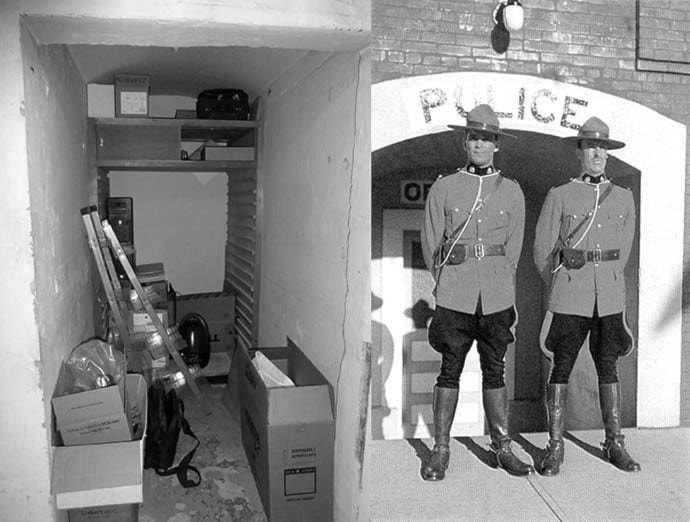Jim Cameron
So, you're working in your office but you're having a little trouble concentrating because of the noise coming from somewhere in the building — possibly on the floor below or maybe somewhere in the basement.
It's not any type of noise in particular, just general office-type hubbub; low murmurs, occasional clatter and thuds — that kind of thing. You move to close your office door, the better to concentrate, and glance out in the hall just in time to catch a fleeting glimpse of a young girl darting out of sight around a corner. Hmm, could it be the daughter of the lady in the Victorian outfit casually floating down the hallway? Oooh-kay.
In fact, the whole thing is rather problematic because you know perfectly well that you're the only one in the building. As for the others, well, there's some say that you're never really alone at City Hall.
Now, the folks who spend time at City Hall are not, and, in all probability, have never been the type who put much truck in the paranormal. They are planners and engineers and organizers and councillors whose business it is to deal with things on a practical level.
Still, it has been a long-known, if quietly spoken fact that Cranbrook's City Hall is a place that can make the hairs on the back of the neck do little dances at times, in particular the old part of City Hall, more precisely the basement which, coincidentally, held the city jail for 50 years. The jail cells are used for storage these days; only one cell has the original barred door remaining as a reminder of days gone by. The basement is not the most popular part of City Hall, if one must go down to grab some files from old jail cell number three, or perhaps some maps from cell six, then that's what one does, as quickly as possible ... or even quicker.
City Hall Gaol opened for business in 1911, replacing two previous ramshackle city lock-ups, one of which was located in the vicinity of the present day Byng Hotel. From a policing point of view, the new jail was a vast improvement, with up to seven cells in use at a time. Escapes from the jail cells were uncommon although they did happen from time to time. Inmates were often utilized as city work crews to improve roadways, parks, creeks and cemeteries and such duties allowed for the occasional wandering-off of prisoners, most of whom were rounded up within a short time.
The jail itself was, and is, not a pretty place. The cement block cells and hallways are cramped, windowless and void of ventilation. A small office area was accessed through a door beneath the original arched 10th Ave. entrance. Another door, added to the south side of the building at a later date, allowed for a prisoner's entrance.
As to the ghosts of City Hall, the simple fact that the cells saw over 50 years of thieves, rapists, murderers, addicts, pushers, embezzlers, gamblers, prostitutes, pimps, the insane and the condemned might account for a general residue of despair lingering about the place. There have been at least four deaths in the basement of city hall, and quite likely more.
Almost all records for the times are lost or otherwise unavailable but it is known that one male prisoner died in custody in 1920 and another in 1927.
There have been numerous suicide attempts that resulted in at least two known deaths. During the evening of Friday, Jan. 25, 1952, Steven Douglas Sidney, age 31, was placed in custody for an undisclosed offense. Born in Outlook, Saskatchewan, Steven was married and worked for the Cominco mine in Kimberley. He was found dead in his cell the same evening, hanging by his belt which he attached to an upper bunk and looped around his neck, allowing him to lean forward to asphyxiate himself. He is buried in the Kimberley cemetery.
William James Margach was also a miner, living in the Canadian Hotel in Kimberley. Hailing originally from Edson, Alberta, William was 40 years of age when he was brought to the Cranbrook jail on a charge of indecent assault on a female. A regular half-hour cell check found him alive at 3 p.m. and hanging dead at 3:30. Mr. Margach made the rope with which he hung himself out of strips of braided cloth torn from the side of his trousers. At the coroner's inquest Dr. Sullivan told the jury, "There is nothing within reason that anyone can do to stop a man that wants to kill himself." Police officers testified that prisoners were always searched upon entering the jail and removed all belts, laces, ties, etc. Three letters were found in a hidden pocket in the dead man's pants. Two were farewell messages and the other a will. The jury found no blame attached to anyone in connection with the death. William Margach's remains were taken to Calgary for cremation.
As Hamlet states: "There are more things in heaven and earth, Horatio, than are dreamt of in your philosophy," which likely includes City Hall. Then again, if a Spirit Abolition Petition submission from the Cranbrook Anti-Apparition Coalition was brought forward, resulting in an appropriate bylaw forcing the removal of the uninvited tenants, well, you can bet that they wouldn't stand a ghost of a chance.
With thanks to the staff of City Hall, past and present.
